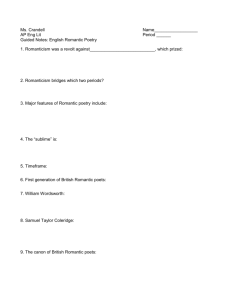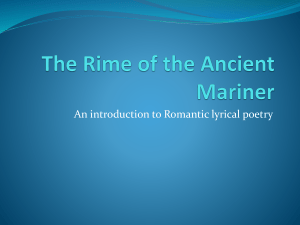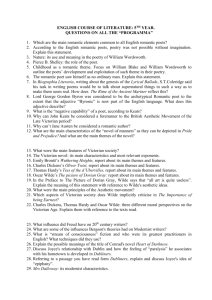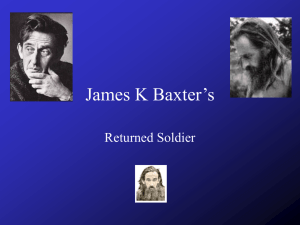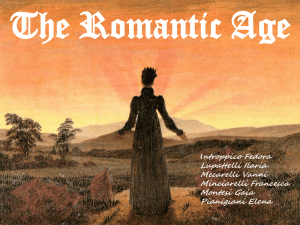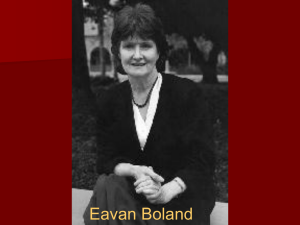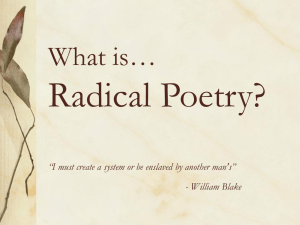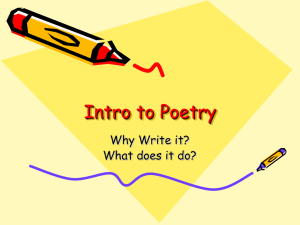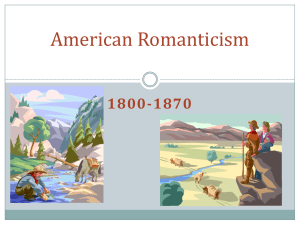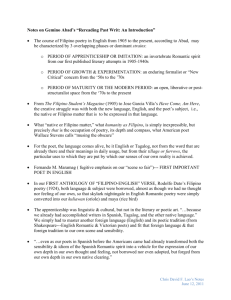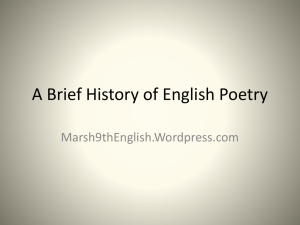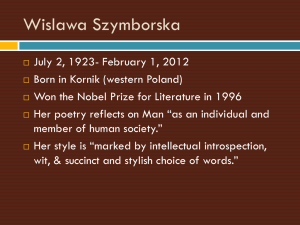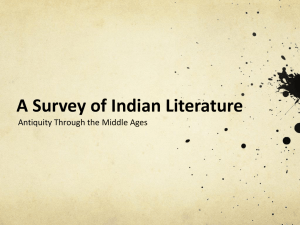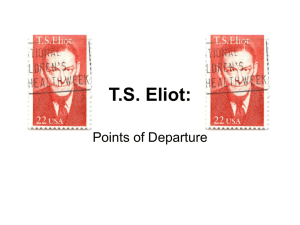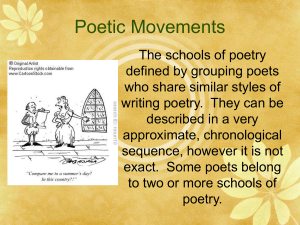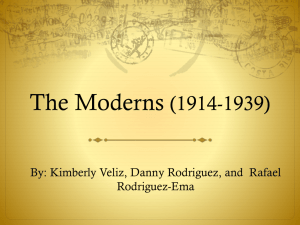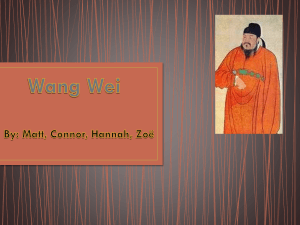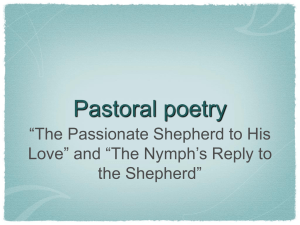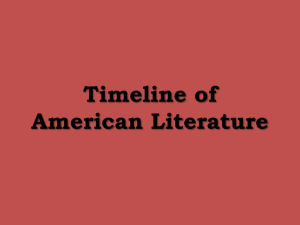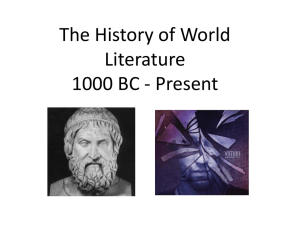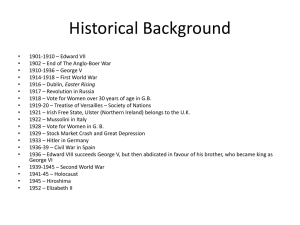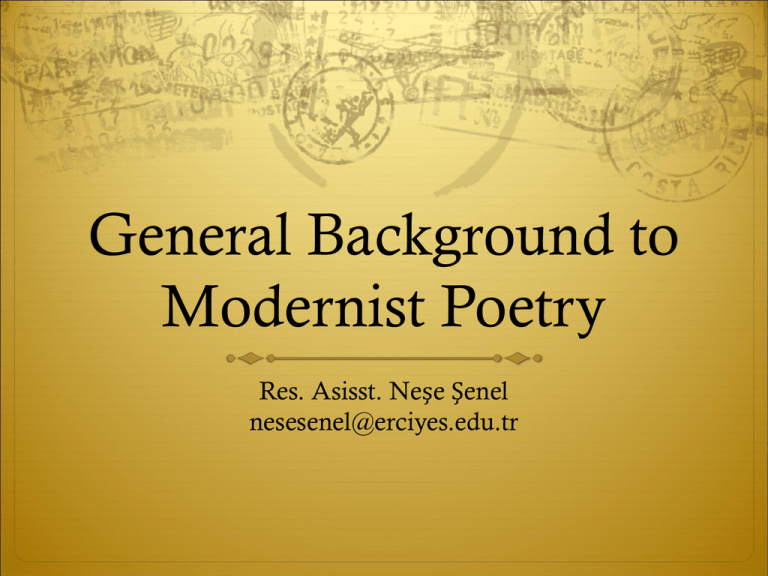
General Background to
Modernist Poetry
Res. Asisst. Neşe Şenel
nesesenel@erciyes.edu.tr
Romantic Poetry (1789-1832)
Early 19th century
Romanticism: “like the old romances” =popularity of the 17th
century French historical romances
Romantic: (improbable adventures away from ordinary life)
“unreal, farfetched, fictitious”
Most of the writers of the era turned away from the principles of
the neo-classical period toward a more imaginative and individual
approach to life and literature.
A focus on the individual.
Optimistic due to their belief in progress and improvement for
humanity.
A rising against the dogma of reason. (limitation of the vision)
Neo-classicism (18th century)( Age of Enlightenment)
Importance on the sober reason
Universality of the reason
A compact, stable society
Works of prose/ age of prose
Focus on the ordinary
Evil as the basic part of human nature
Usual, simple, direct
Indifferent to social problems
Romanticism
Importance of passion and sensibility
Emphasis of the diversity of the truth
Unstable, revolutionary society
Works in poetry, age of poetry
Focus on the extraordinary, imagination
Innate goodness of the man, corrupted by the society and
institution
Unusual complex and fanciful: symbolism
Everyday language
A broad humanitarianism
An attempt to go beyond what is ordinary reality into a
deeper one.
Unlike neo-classics, romantics enjoyed the medieval
atmosphere, mystery and super natural.
But NATURE was always in the center of their vision
Return to Nature
An awareness of the nature comes to foreground.
For its wilderness, magnificence and solitude.
New meanings to the common things that are present in the
nature.
Romantic Melancholy
The pleasures of nature were filled with melancholy. A
harsh and gloomy one. Philosophizing upon man, death,
immortality.
Primitivism
The natural condition of men is the best condition.
Glorification oh the primitive and the natural.
Idealization of the child and childhood.
Sentimentalism
Man’s emotions, instincts and passions.
The poor and the oppressed gained dignity.
All the living people are respected as the parts of humanity.
The sense of brotherhood.
Individualism and Exoticism
Imaginative sensibility is reflected without any moral or
social restraint.
Confessing the sins, passions, desires, aspirations, grief etc.
Self-revelation poems
The Medieval Revival
Not classics nut the romantic poets
Providing the material with the distant, unfamiliar and
mysterious.
William Blake
William Wordsworth
Samuel Taylor Coleridge
Lord Byron
Percy Bysshe Shelley
John Keats
Victorian Age (1830-1901)
England as the most powerful empire.
William IV – Queen Victoria
Bourgeoisie dominancy/ A transition between the
stability of the 18th century and instability of the 19th
century
Contradictions, rebellions, rapid transformations
Industrial and scientific revolution
Early Victorian Period(1832-1870)
From an agricultural society to industry
Problems like poverty, prostitution, unemployment
Emergence of the working class
Mid-Victorian Period (1848-1870)
Debate between science vs. religion.
England as the shining country. Rich and prosperous.
Man’s accidental existence in an indifferent universe.
Utilitarianism: using the facilities of the government for the benefit of
the majority.
“Religion is useless”
Oxford Movement: going back to traditional kind of religion
Late Victorian Period
The power of England is threatened by the USA and
Germany
Communist and Marxist ideas affecting people ( Karl Marx)
Several movements, bills, acts, unions, labor parties.
Literary Background
Novel as the most popular genre.
Dickens, Hardy, Eliot, Bronte sisters, Austen
Romantic tradition could not be followed because the
rebellious feature of the romantic poets was not tolerable due
to the new social structure.
Romantic imagination -excessive for Victorian rationality
Romantic love of nature remained yet merged together with a
new scientific observation.
Fascination with the medieval past continued.
Alfred Tennyson
•
Nationalistic poet, commonly accepted social values of
the period.
•
The emotional and intuitive technique
Robert Browning
•
The emotional and intuitive technique
•
A new technique by adding a dimension of realism
•
Dramatic monologue: objective person speaking-poetic
persona
Mathew Arnold
•
Pessimistic about Victorian society.
•
No reconciliation between science and religion.
An England, which is no more secure ( Germany, USA)
Pessimism, escapism were dominant.
Two major attitudes toward poetry:
1. Religious Poetry
2. Pre-Raphaelite Poetry
•
Art for art’s sake. An aesthetic movement.
•
Painters who lived before Raphael.
•
An escape from the realities of the Victorian Period into
a world of aesthetics.
•
Highly descriptive poetry.
Poetry of World War I
No patriotic poems anymore for the British superiority.
Those poets who fought at the front realized the full
horror of war, affecting their imaginations and poetic
techniques.
TH
20
Century
MODERNISM in Poetry
Poetry of Negation: Poets alienating themselves from
the society, negating the communicative function of art.
The Narrative Protest: VS. Poetry of Negation.
Connection between art and life. Content is more
important than the form.
Edwardian Period, 19011910
A period of uncertainty. Criticized for its luxury.
Alfred Austen.
A nostalgia for the past.
How to live in a scientific world? How to cope with the
impacts of Industrial revolution?
A reaction to “Art for art’s sake”
Thomas Hardy belonged to this period.
Georgian Period
A revolt against Edwardian period in two different ways.
1. Revolutionary and experimental (T.S. Eliot -Ezra Poundmodernist poetry)
2. A moderate attitude. Optimistic style on rural life,
beauty of nature as a subject matter. Escaping from
modernist topics.
IMAGISM
A style of writing and criticizing poetry articulated by
Ezra Pound, 1912. A manifesto of imagism against the
dictation of romanticism.
T.E. Hulme. The Poet’s club. Free verse, concrete
language, primacy of image. The ground for modernism
is established by Hulme, yet it as a movements started by
Pound when he announced to poets to be imagists.
Imagist doctrine:
Direct treatment of the “thing” whether objectibe or
subjective.
The use of absolutely no word that does not contribute
to the presentation
A freer metrical sequence- FREE VERSE
SYMBOLISM
In France, 1860s- 1920s. An indirect expression. A
symbol is not a representation of life but an evorsion of
it. Suggestive and allusive images.
Modernism (1890-1930)
A radical break with the 19th century aesthetics.
Developing new forms of artistic expression to go beyond the
conventional ideas of life and art.
Freud and Jung: Human mind is disorderly and ideas are
discontinues. Recurrent motifs. Accidental interruptions.
Collective unconsciousness. Myths are interpreted into
modern experience.
Henri Bergson. Time. Clock time is artificial but the mental
time which is the stream of non-thinking impulse is real.
Poetry reflects complexity of existence. Multiplicity of reality.
Experimenting with the new forms.
Private language is used as they believed that there is no
common general truth.
FREE VERSE
The poems have moment’s context.
Urban life, corrupted city. They forbidden such matters as sex
and challenged the subject matter of the bourgeoisie.
Poet’s inner reality came to the front.
Open ended poems.
Social , traditional values and the sense of unity is
destroyed.
Poet should be someone elite with a privileged mind,
speaking to an elite audience. Avant- Garde.
Modernist art is about individuals and minds.
Against materialistic society.
Multiple and individual realisms.
The corrupted city life, the wastedness of the individuals,
death, frustration, disillusionment, alienation,
fragmentation were pre-occupying the artists’ minds.
Truth is temporary not absolute, gained by personal
experience.

